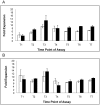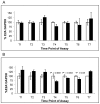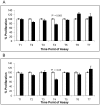Effects of fenbendazole on the murine humoral immune system
- PMID: 19476712
- PMCID: PMC2696826
Effects of fenbendazole on the murine humoral immune system
Abstract
Pinworms are highly contagious parasites that have been effectively treated in laboratory rodents with fenbendazole (FBZ). Whether FBZ has any detrimental side effects that may compromise experimental results is unknown. Here we asked whether the immune systems from young and aged mice are altered under FBZ treatment. We compared control and FBZ-treated groups of young (age, 2 to 4 mo) and old (age, 22 to 24 mo) BALB/cN mice. The treated mice received a total of 4 wk (alternating-week treatment regimen) of FBZ-medicated feed. Spleen and bone marrow were collected for immunologic assays, and heart, stomach, intestines, kidneys, and liver were evaluated by histopathology. Our results indicate that FBZ treatment has significant effects on the immune systems of mice; these effects are greater in aged mice. FBZ treatment adversely affected mRNA and protein expression of E2A (a transcription factor crucial for B lymphocytes) in activated precursor B lymphocytes obtained from the bone marrow of young and old mice. These effects were reversed by 6 wk on regular feed after the end of treatment. Activated B lymphocytes from the spleens of young and old mice showed decreased function (cell proliferation, E2A mRNA and protein expression) through the last time point of FBZ treatment but recovered by 2 to 4 wk after treatment. Our findings suggest that FBZ treatment may alter sensitive immune and molecular measures as presented here, and postponing the experimental use of mice until at least 6 wk after treatment should be considered.
Figures







Similar articles
-
Effect of fenbendazole on an autoimmune mouse model.J Am Assoc Lab Anim Sci. 2013;52(3):286-9. J Am Assoc Lab Anim Sci. 2013. PMID: 23849411 Free PMC article.
-
Effects of fenbendazole on routine immune response parameters of BALB/c mice.J Am Assoc Lab Anim Sci. 2008 Nov;47(6):32-6. J Am Assoc Lab Anim Sci. 2008. PMID: 19049250 Free PMC article.
-
Biologic effects of fenbendazole in rats and mice: a review.J Am Assoc Lab Anim Sci. 2007 Nov;46(6):8-15. J Am Assoc Lab Anim Sci. 2007. PMID: 17994667 Review.
-
Cellular immune responses in peripheral blood lymphocytes of Giardia infected squirrel monkey (Saimiri boliviensis boliviensis) treated with Fenbendazole.PLoS One. 2018 Nov 9;13(11):e0198497. doi: 10.1371/journal.pone.0198497. eCollection 2018. PLoS One. 2018. PMID: 30412580 Free PMC article.
-
Strain-related effects of fenbendazole treatment on murine experimental autoimmune encephalomyelitis.Lab Anim. 2010 Jul;44(3):271-3. doi: 10.1258/la.2010.009148. Epub 2010 May 10. Lab Anim. 2010. PMID: 20457828
Cited by
-
Fenbendazole improves pathological and functional recovery following traumatic spinal cord injury.Neuroscience. 2014 Jan 3;256:163-9. doi: 10.1016/j.neuroscience.2013.10.039. Epub 2013 Oct 30. Neuroscience. 2014. PMID: 24183965 Free PMC article.
-
Effect of fenbendazole on an autoimmune mouse model.J Am Assoc Lab Anim Sci. 2013;52(3):286-9. J Am Assoc Lab Anim Sci. 2013. PMID: 23849411 Free PMC article.
-
Effects of low-dose oxygen ions and protons on cardiac function and structure in male C57BL/6J mice.Life Sci Space Res (Amst). 2019 Feb;20:72-84. doi: 10.1016/j.lssr.2019.01.003. Epub 2019 Jan 15. Life Sci Space Res (Amst). 2019. PMID: 30797436 Free PMC article.
-
Use of fenbendazole-containing therapeutic diets for mice in experimental cancer therapy studies.J Am Assoc Lab Anim Sci. 2012 Mar;51(2):224-30. J Am Assoc Lab Anim Sci. 2012. PMID: 22776123 Free PMC article. Clinical Trial.
-
Variation in airway responsiveness of male C57BL/6 mice from 5 vendors.J Am Assoc Lab Anim Sci. 2012 Jul;51(4):401-6. J Am Assoc Lab Anim Sci. 2012. PMID: 23043804 Free PMC article.
References
-
- Bain G, Robanus Maandag EC, Riele HP, Feeney AJ, Sheehy A, Schlissel M, Shinton SA, Hardy RR, Murre C. 1997. Both E12 and E47 allow commitment to the B cell lineage. Immunity 6:145–154 - PubMed
-
- Cabaj W, Stankiewicz M, Jonas WE, Moore LG. 1994. Fenbendazole and its effect on the immune system of the sheep. N Z Vet J 42:216–220 - PubMed
-
- Coghlan LG, Lee DR, Psencik B, Weiss D. 1993. Practical and effective eradication of pinworms (Syphacia muris) in rats by use of fenbendazole. Lab Anim Sci 43:481–487 - PubMed
-
- Frasca D, Nguyen D, Riley RL, Blomberg BB. 2003. Decreased E12 and/or E47 transcription factor activity in the bone marrow as well as in the spleen of aged mice. J Immunol 170:719–726 - PubMed
Publication types
MeSH terms
Substances
Grants and funding
LinkOut - more resources
Full Text Sources
Medical
